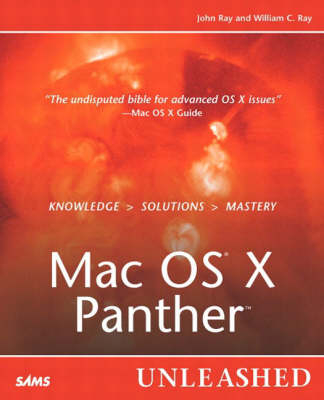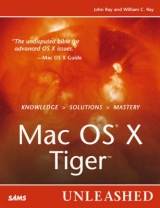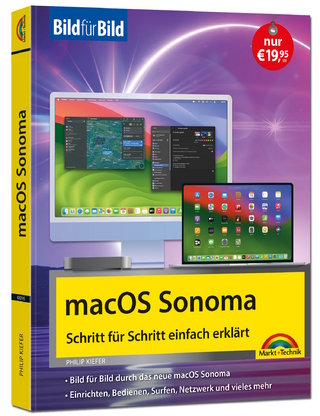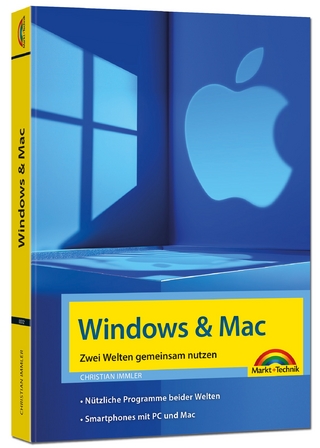
Mac OS X Panther Unleashed
Sams Publishing (Verlag)
978-0-672-32604-2 (ISBN)
- Titel erscheint in neuer Auflage
- Artikel merken
Often hailed as one of the most thorough, well-written books on the subject, Mac OS X Panther Unleashed is all you will ever need in order to learn the Mac OS X operating system and the BSD Unix underlying system. The new Mac OS X has added performance and interface enhancements, which further extends the capabilities of the underlying subsystem. Unleashed teaches you how to get the most out of your operating system by focusing on the subsystem. It will also show you how to deal with the most trouble-prone aspects of the user interface. Whether you're new to Mac OS X or you're a skilled user, as long as you're familiar with the basics of the Mac OS drag and drop and menu functions, Unleashed will be able to show you how to get the most out of your Mac operating system!
John Ray is an award-winning application developer and security consultant with more than 20 years of programming and administration experience. He has worked on projects for the National Regulatory Research Institute, The Ohio State University, Xerox and the state of Florida, as well as serving as the IT director for a multimillion dollar design and technology firm. A Macintosh owner and programmer since 1984, John has written/contributed to numerous titles including Maximum Mac OS X Security, Sams Teach Yourself Macromedia Studio MX 2004 All in One, Sams Teach Yourself Mac OS X and Panther All In One. William Ray is a mathematician turned computer scientist turned biophysicist who has gravitated to the field of bioinformatics for its interesting synergy of logic, hard science, and human-computer-interface issues. Will is currently a Professor of Pediatrics at the Columbus Children's Research Institute Children's Hospital in Columbus, Ohio, and the Department of Pediatrics, The Ohio State University, where he is investigating tools that work at the interface between humans, computers, and information, and working to build a core computational research and training facility for his institute. Joan Ray (Contributing Author) is a Unix system administrator and Webmaster for the College of Biological Sciences at The Ohio State University. Joan has a degree in French from OSU and is working toward additional degrees in Japanese and geology. When not helping with this or other books, Joan is administering a cluster of SHI and Sun Unix workstations and servers; helping and providing training for users with Unix, Classic Mac OS, and Mac OS X questions; and serving as college Webmaster.
(NOTE: Each chapter concludes with a Summary.)
Introduction.
Here's To the Crazy Ones. Mac OS X Panther Unleashed.
I. INTRODUCTION TO MAC OS X.
1. Panther System Elements.
The Mac OS X Layers. What's New in Panther. Mac OS X Basics. The Filesystem—Where Did Everything Go? The Apple Menu. Windows. The Application Menu. Menu Extras. Additional OS Components. Help Center.
2. Managing the Panther Workspace.
Using the Finder. Finder Windows. Finder Views. The Go Menu. Browsing Network Volumes. Finder File Operations. Getting File Information. The Desktop. Burning CD/DVDs. Using Fast User Switching. Finder Preferences. Using the Dock. Customizing the Dock. Process Manager: Force Quitting Applications. Window Management with Exposé.
3. Applications and Utilities.
Address Book. iCal. iSync. Preview. DVD Player. Keychain Access. Apple System Profiler. Activity Monitor. Console. Disk Utility. The Classic Environment. Ink. The Bluetooth Suite. Other Tools and Utilities.
4. Internet Applications.
Safari. Mail. iChat AV. Sherlock. .Mac.
5. Installing Third-Party Applications.
Software Sources and Formats. Using StuffIt Expander. Installing Software. Interesting Software.
II. MAC OS X MEDIA TOOLS.
6. Photography and Imaging.
iPhoto. The iPhoto Interface. Image Capture.
7. Audio.
Sound Preferences. iTunes. Recording Audio in Panther. Audio MIDI Tool.
8. Digital Video.
Multimedia Software. QuickTime 6. iMovie. iDVD.
III. USER-LEVEL OS X CONFIGURATION.
9. Network Setup.
TCP/IP. The Network Preferences Pane. AppleTalk. The Sharing Control Pane. Connecting to Remote Servers. Managing Locations. Testing Network Settings.
10. Printer, Fax, and Font Management.
Print Center. The CUPS System Interface. Printing. Managing Fonts. Font Web Sites.
11. Additional System Components.
User Account Creation. Using NetInfo Manager. Using the NetInfo Database to Customize a User. Enabling the root Account. Groups. System Preferences: Personal. System Preferences: Hardware. System Preferences: System.
IV. INTRODUCTION TO BSD APPLICATIONS.
12. Introducing the BSD Subsystem.
Unix-Based Mac OS. BSD Philosophy. Using Terminal. Interacting with Unix: Basic Unix Commands. The Unix Filesystem. Basic Filesystem Navigation. Terminal Preferences and Configuration.
13. Common Unix Shell Commands: File Operations.
Rearranging Files. Examining File Contents. Deleting Files. Searching for Files, Directories, and More. File Compression and Archiving.
V. ADVANCED COMMAND-LINE CONCEPTS.
14. Advanced Shell Concepts and Commands.
Introduction to File Permissions. Process Management. Communication Between Processes: Redirection, Pipes.
15. Command-Line Applications and Application Suites.
Networking Applications. Mail Clients. Text Editors. Printing Tools. Bridging the GUI to Command Line Gap: Hybrid Software.
16. Command-Line Software Installation.
Installing the Developer Tools. Installing Software at the Command Line.
17. Troubleshooting Software Installs, and Compiling and Debugging Manually.
Common Sense and Configuration Options. File Locations and Fighting with Installers. Using the gdb Debugger. Recommended Command-Line Software Installations.
18. Advanced Unix Shell Use: Configuration and Programming (Shell Scripting).
Customizing Your Shell Environment and Storing Data. Automating Tasks with Shell Scripts. Making Shell Scripts Start at Login or System Startup.
VI. SERVER/NETWORK ADMINISTRATION.
19. X Window System Applications.
Introduction to the X Window System. Installing the XFree86 OS X Distribution. Using X11. Configuring the X Window System. Installing Some Additional Interesting X11 Software.
20. Command-Line Configuration and Administration.
Locating and Editing the OS X Configuration Files. System Services. Strong-Arming the System—Brute Force Behavior Modification.
21. Scripting Languages.
Introduction to AppleScript. Script Editor. AppleScript Syntax. Perl. Python.
22. MySQL and Database Connectivity.
Getting Started with MySQL. Creating a MySQL Database. Perl/MySQL Integration. iODBC and ODBC Manager.
23. File and Resource Sharing with NFS and NetInfo.
Single-User Mode. Using the NetInfo Database and NFS to Share Resources. Restoring the Local NetInfo Database.
24. User Management and Machine Clustering.
Skeleton User Accounts. Multiple Users and Multiple Machines: Creating Clusters. Cooperating Without Clusters. Command-Line Administration Tools.
25. FTP Serving.
Activating the FTP Server. FTP Server Options. Setting Up Anonymous FTP. Using wu-ftpd as a Replacement for the Default ftpd. Alternatives to FTP.
26. Remote Access and Control.
Security-Minded Thinking. What Is Secure Shell? Activating the SSH Server. Basic Configuration. Basic Use. Advanced Use. Clients. Control Commands.
27. Web Serving.
Apache. Apache Configuration. Rebuilding and Securing Apache. WebDAV—mod_dav. Streaming MP3s—mod_mp3. Show Me Something to Impress My Friends!
28. Web Programming.
Introduction to Web Programming. Programming CGIs in Perl. PHP. Alternative Development Environments.
29. Creating a Mail Server.
Running a Mail Server. Activating Postfix. Postfix Configuration. University of Washington imapd. Web-Based Email.
30. Windows Interoperability.
Introduction to SMB and CIF. Accessing and Sharing Windows Resources. Samba.
VII. SYSTEM AND SERVER HEALTH.
31. Server Security and Advanced Network Configuration.
Why Bother with Network Security. Disabling Access. Intrusion Detection. Where to Go from Here.
32. System Maintenance.
Software Updates. Backups. Mac OS X Native GUI Backup Utilities. Command-Line Backups. Diagnostics and Repairs. Housekeeping.
VIII. APPENDIX.
Appendix A. Command-Line Reference (on the www.samspublishing.com Web site). PDF:1577.
Index.
| Erscheint lt. Verlag | 22.1.2004 |
|---|---|
| Verlagsort | Indianapolis |
| Sprache | englisch |
| Maße | 230 x 187 mm |
| Gewicht | 2413 g |
| Themenwelt | Informatik ► Betriebssysteme / Server ► Macintosh / Mac OS X |
| Wirtschaft ► Betriebswirtschaft / Management ► Wirtschaftsinformatik | |
| ISBN-10 | 0-672-32604-3 / 0672326043 |
| ISBN-13 | 978-0-672-32604-2 / 9780672326042 |
| Zustand | Neuware |
| Haben Sie eine Frage zum Produkt? |
aus dem Bereich



